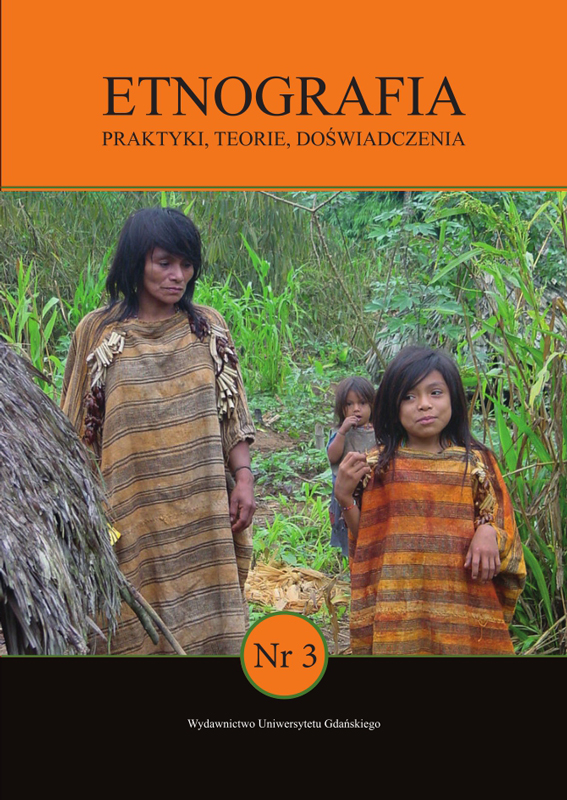Wojna i pokój w społeczeństwie Bora w Amazonii peruwiańskiej
DOI:
https://doi.org/10.4467/254395379EPT.17.012.9248Słowa kluczowe:
Social conflict, Bora, gente del centro, cultural mechanisms of conflict resolution, méémeba, the Peruvian AmazonAbstrakt
In the article, I discuss the social conflict and violence as well as cultural methods of their neutralization in the culture of Bora Indians from the Peruvian Amazon. The conflict in a small Amazonian community, in which everyone knows each other, is conditioned by the relationships of blood and affinity. The cultural forms of neutralization of the conflict are: migration from places with intense conflict, ceremonial and festive ceremonies. Bora stigmatize each other when their traditional categories of social coexistence – sharing, mutual help, caring for the common good – fail in confrontation with values of the national society.
Downloads
Bibliografia
Coser, L.A. (2009). Funkcje kofliktu społecznego. Kraków: Nomos.
Churay Flores, V. (2001). Fiestas tradicionales de los boras. Lima: Universidad Nacional Mayor de San Marcos.
Chaumeil, J.-P. (1981). Historia y migraciones de los Yagua de finales del siglo XVII hasta nuestros dias (s. 16–18). Serie Antropologica No. 3. Lima: CAAP.
Echeverri, J.A. (1997). The people of the center of the world. A study in culture, history and orality in the Colombian Amazon. New York: New School for Social Research, Faculty of Political and Social Science.
Gasché, J. (2007). ¿Para qué sirve el concepto de ‘sociedad bosquesina’?. Folia Amazónica, 16(1–2), 81–88.
Gasché, J. (2009). La sociedad de la “gente del centro”. W: F. Seifart et al. (eds.), A multimedia documentation of the languages of the People of the Center. Nimega: DOBES-MPI, www.corpus1.mpi.nl/qfs1/mediaarchive/dobes_data/Center/Info/1.3_Sociedad.pdf. [dostęp: 25.10.2017].
Miraña, J.E., Franco, R., Bora, A.B. (2009). Testimonios y Relatos para la historia de los mirañas y boras del río Cahuinarí (1710–2008). Bogotá: AATI Pani.
Novati, J. (1984). Mekamunaa: estudio etnomusicologico sobre los Bora de la Amazonia Peruana. Buenos Aires: Institutio Nacional de la Musicología “Carlos Vega”.
Overing, J., Passes, A. (eds.). (2002). The Anthropology of Love and Anger: the Aesthetics of Conviviality in Native Amazonia. London–New York: Routledge.
Santos Granero, F. (1991). The Power of Love. The Moral Use of Knowledge amongst the Amuesha of Central Peru. London: The Athlone Press.
Thiesen, W., Thiesen, E. (1998). Diccionario bora-castellano, castellano-bora. Lima: Instituto Linguistico de Verano.
Wright, R. (2012). Arawakan Flute Cults of Lowland South America: The Domestication of Predation and the Production of Agentivity. W: J.H. Hill, J.-P. Chaumeil (eds.), Bursts of Breath: New Research on Indigenous Flutes in Lowland South America (s. 325–356) Omaha: University of Nebraska.
Viveiros de Castro, E. (1992). From the Enemy’s Point of View: Humanity and Divinity in an Amazonian Sociaty. Chicago: University Chicago Press.
Pobrania
Opublikowane
Jak cytować
Numer
Dział
Licencja
Czasopismo wydawane jest na licencji Creative Commons Uznanie autorstwa-Na tych samych warunkach 4.0 Międzynarodowe.

 Uniwersyteckie Czasopisma Naukowe
Uniwersyteckie Czasopisma Naukowe








